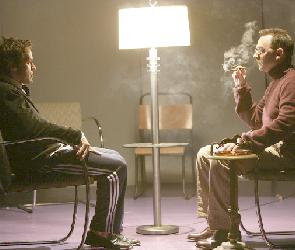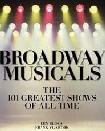SEARCH CurtainUp
REVIEWS
FEATURES
NEWS
Etcetera and
Short Term Listings
LISTINGS
Broadway
Off-Broadway
BOOKS and CDs
OTHER PLACES
Berkshires
London
LA/San Diego
DC
Philadelphia
Elsewhere
QUOTES
On TKTS
LETTERS TO EDITOR
FILM
LINKS
MISCELLANEOUS
Free Updates
Masthead
Writing for CurtainUp
Hamlet
By Kathryn Osenlund

Left to Right: Rob Campbell as Hamle & Michael Emerson as the Ghost of Hamlet's father.
(Photo: T. Charles Erickson)
|
Hamlet is playing in Princeton at McCarter's Berlind Theater -- re-packaged, sliced and diced. It's a production that should start fist fights.
Director Daniel Fish's vision begins with a group of stressed out people sitting at a table in bright flat light, in what looks like a mismatched office cafeteria. The set makes a virtue of incompleteness, as if its being too finished would trap the players into a conventional performance.
Hamlet (Rob Campbell), back to the audience, sits off to the side. What we are seeing is the watch scene on the battlements, played indoors by characters who soon will take lead roles. For those not intimate with the play, the opening can be confusing. Hamlet's position, isolated and detached, appears to set the scene for a familiar understanding of his psychic terrain. However, this is to be a hot Hamlet, emotionally engaged. Far from withdrawn, he is already in tears for his opening line.
This production operates by unexpected rules. Missing is the tacit understanding of when characters do or do not "see" or "hear" each other on stage. One moment a character may walk right by another--unseen; and the next moment, as called for, he is seen. Sometimes characters do not hear what they clearly can hear --beyond the conventions of suspended disbelief for soliloquies -- yet at times they can hear others' soliloquies. For example, in a twist, Claudius, whose killing has been deferred because he was at prayer, speaks his last line directly to Hamlet, as if to say, "Ha! Fooled you. I heard you talking and I really wasn't into the prayer anyway."
The "To Be" soliloquy is relocated. It occurs soon after Hamlet's "speak the speech" advice to the players. This placement provides an opportunity to have some fun with it first. Hamlet corrects the Player King's delivery of "To be or not to be," as if this speech--yet to be delivered in this production -- has become a piece of rote theater, which, of course, it often has. Shortly afterward Hamlet delivers the soliloquy and does it well, although in this context it loses much of its edge.
There are only eight actors. Double casting sometimes muddles the play, but other times it is inspired. Using the same actor [Michael Emerson] in the roles of Hamlet's dead father and Claudius really works, with new recognitions pinging off the lines and creating new trajectories. In this vein, one of director Fish's most intriguing decisions is to have Gertrude and Claudius read the Queen and King roles in the play within a play, producing a scene gloriously theatrical and fraught with meaning: Hamlet hands out scripts for the evening's staged reading. Gertrude reads the queen role, saying the words that damn her, and then complaining, as Gertrude, that "the lady doth protest too much."For his part, Claudius, horrified, gags as the meaning of what he is reading dawns on him.
In another brilliantly conceived moment the audience gets a Polonius-eye view of the Hamlet-Gertrude scene. Polonius is on the audience side of the proscenium curtain, which is not fully lowered. We can see the lower half of the mother and son as they speak. With Polonius's fatal shooting [yes, he's shot] the curtain is raised and he falls into the scene dead, victim of his own espionage. In this closet scene Gertrude, complicit, sees the ghost. Traditionally she would not.
A discordant note, but one evidently intrinsic to Fish's vision, is the entrance, one by one, of many young boys, who stand frozen as Hamlet delivers the "How all occasions do inform against me" soliloquy. He refers to Fortinbras' army and renews his resolve, then the little boys leave. At the end the boys will reappear in matching business suits with Fortinbras. Are they intended as evidence of Hamlet's madness? If so, they don't succeed. Instead, they make you wonder about the director's sanity. Sadly, in today's zeitgeist, gratuitously appearing young boys can conjure Neverland.
A few notes on the cast: Both Polonius and the gravedigger are played by David Margulies. He delivers an unusually sympathetic Polonius-- warm, fuzzy, and sensible as the father, yet foolish before the royals. It becomes even more understandable that Laertes would be so very bereft and furious when he is killed. Ophelia, played with wit and brio by Carrie Preston, is rather the classic Ophelia, except when she gleefully leaps on to those she loves. If the idea here is that Hamlet emerges from the play because it can not contain him, then Rob Campbell's Hamlet needs to act out more and sooner. Even his mad nudity lacks abandon. If you're going to break the rules, at least go for it. Michael Emerson's several roles (Ghost, Claudius, Guildenstern, Osric) are successful in varying degrees. Least effective is the ghost, played pedestrian and bureaucratic, but this must be the director's vision of the role. Emerson's Claudius is more interesting, although not the slick, smiling villain he is intended to be. Frank Wood's Player king is played against expectations and Stephanie Roth Haberle's Gertrude is youthful and distant. Her Rosencrantz is a goof ball, just like Guildenstern. With all the watching and spying going on, Hamlet can trust only sturdy, white-bread Horatio, a role both lackluster and thankless, but ably played by Haynes Thigpen. Jesse J. Perez comes across a bit stiff as a hotheaded Laertes.
Characters are costumed in nerdy, non-matched clothes with a jumble sale look. Hamlet wears a black long-sleeved T-shirt over a white shirt with tie, shirttails hanging out over navy sweat pants with white stripes. Polonius wears a loud, awful shirt, and Ophelia sports a big black and yellow sweater that looks like a bee, over a light purple "mad Ophelia" dress. Partnered with the set design, nothing is too congruent here. The sound design is quite complex and interesting. At times characters play records, and the sound takes off from there, sometimes almost subliminally.
Shakespeare's Hamlet, directly and indirectly responsible for many deaths, retains a hero's reluctance and noble innocence. Crazy or not, his mental state does not allow arbitrary killing. Fish's Hamlet, however, suddenly careers off, twisted and murderous, impaling Claudius in a vicious attack, followed by the cold-blooded dispatch of an innocent friend in an out-of-character murder. This departure is a radical remove from Shakespeare's play. Granted, creating art is about taking liberties, and the director can shake up the rules, but how far does license extend? For centuries Hamlet has been re-interpreted, pared, jazzed up, and bent to reflect issues of the day. Certainly it supports a number of interpretations. But this production returns to the eighteenth century penchant for changing outcomes and "improving" on Shakespeare. Haven't those bad old days been abandoned in favor of a preference for reclaiming Shakespeare's own work?
Yet, here is another controversial Hamlet contributing to the galaxy of Hamlets. It's good for the state of the art when directors tackle the job, fashioning their fresh, peculiar takes on Shakespeare's delayed action figure, even as each age proves Hamlet once again unresolvable. But can the basic story be altered with impunity? Perhaps Daniel Fish will be visited by the shade of Shakespeare. Will the Bard be pleased or pissed off?
|
HAMLET
By William Shakespeare Directed Daniel Fish Cast: Rob Campbell, Michael Emerson, Stephanie Roth Haberle, David Margulies, Jesse J. Perez, Carrie Preston, Haynes Thigpen, Frank Wood Set Design: John Conklin Lighting Design: Scott Zielinski Costume Design: Kaye Voyce Sound Design: Darron L. West, additional music Polly Pen Running time: 3 hours including one 15 min intermission Berlind Theatre, Princeton, NJ 05/03/05 to 06/19/05 Reviewed by Kathryn Osenlund based on 05/11 performance at the |

Easy-on-the budget super gift for yourself and your musical loving friends. Tons of gorgeous pictures.

Retold by Tina Packer of Shakespeare & Co.
Click image to buy.
Our Review

At This Theater

Leonard Maltin's 2005 Movie Guide

Ridiculous!The Theatrical Life & Times of Charles Ludlam

6, 500 Comparative Phrases including 800 Shakespearean Metaphors by CurtainUp's editor.
Click image to buy.
Go here for details and larger image.



